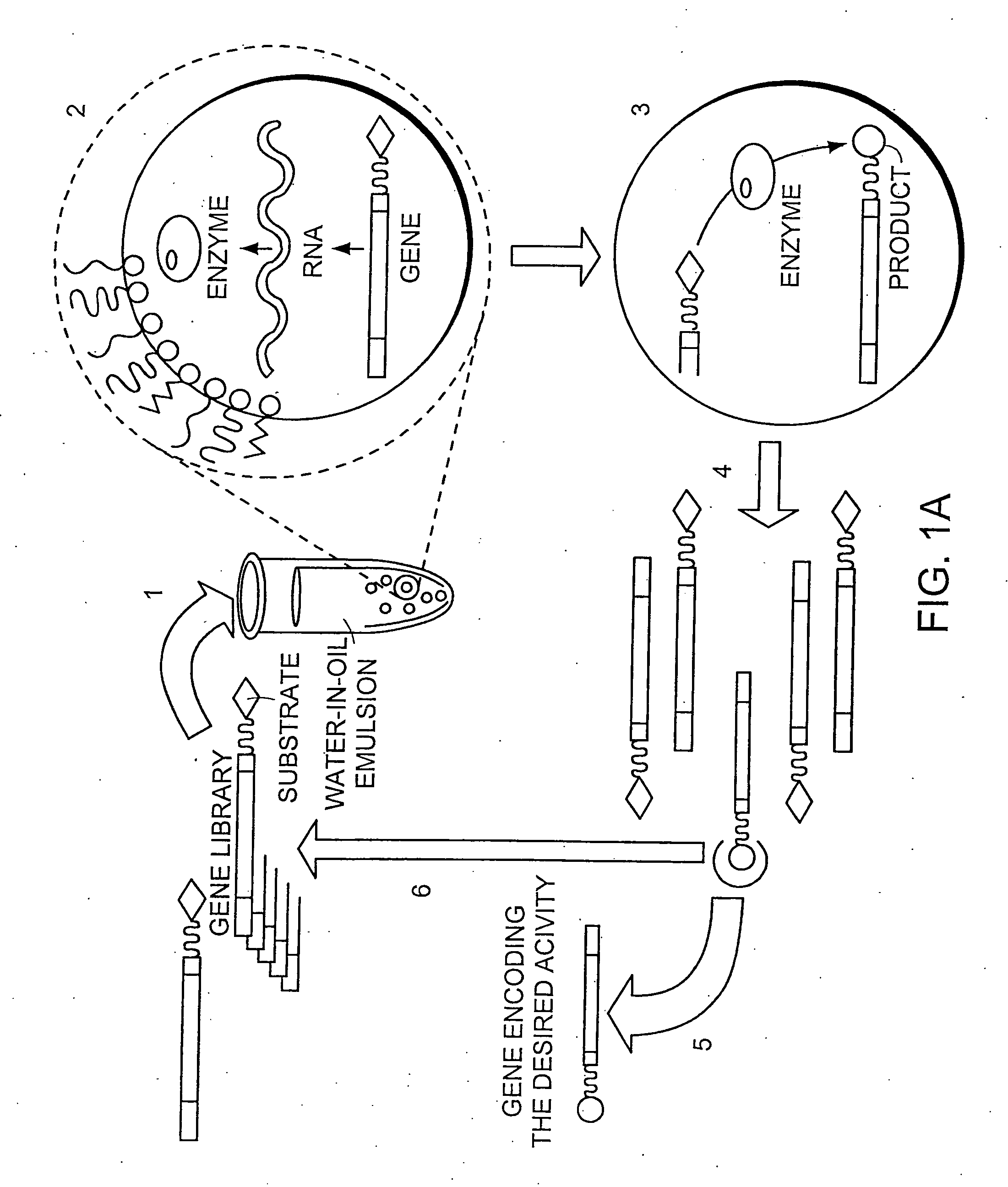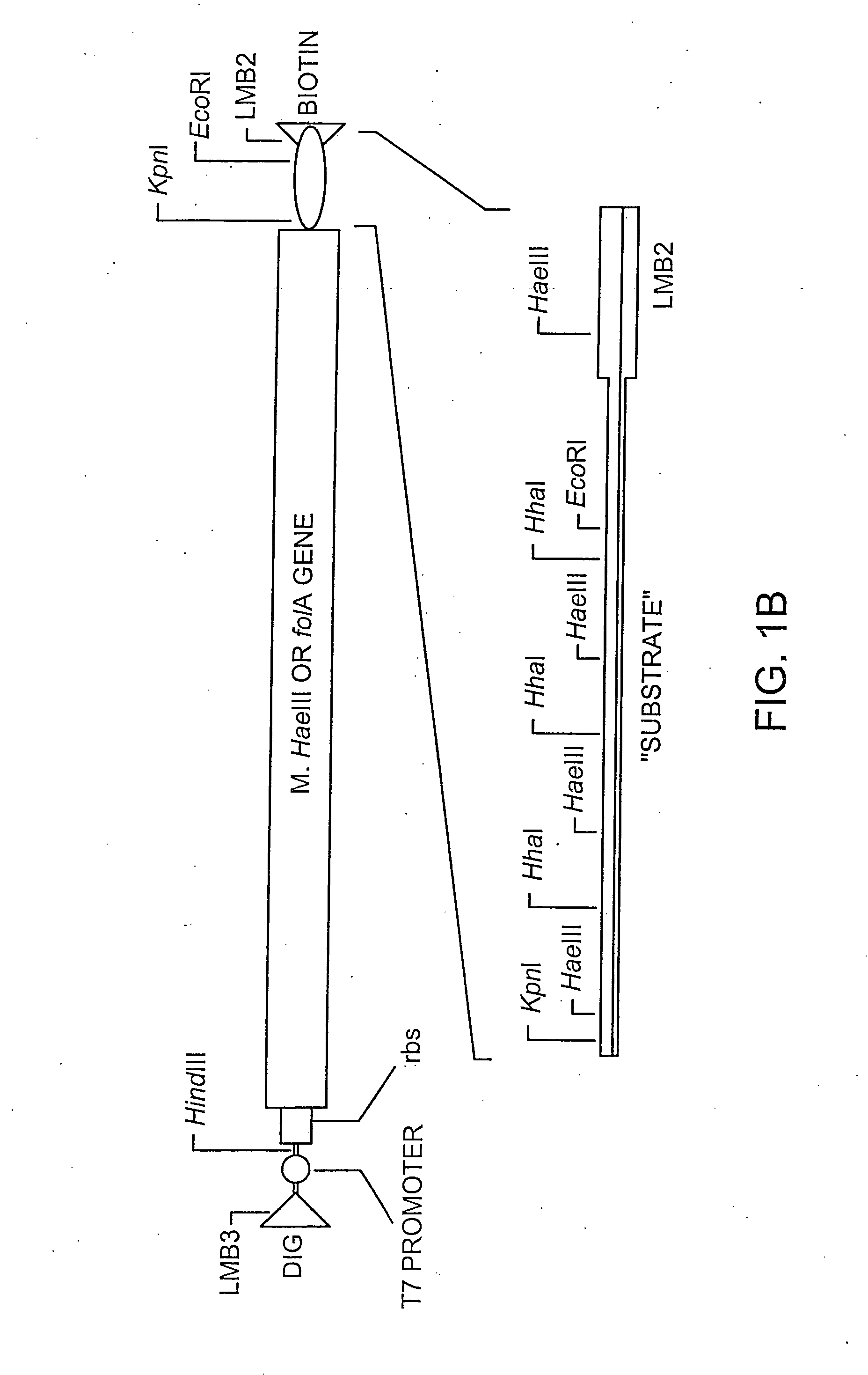In vitro sorting method
a sorting method and in vitro technology, applied in the field of in vitro sorting method, can solve the problems of limited scope of the above-mentioned system, limited library size allowed by phage display technology, and inability to direct select activities, etc., to achieve the effect of enhancing the activity of gene products
- Summary
- Abstract
- Description
- Claims
- Application Information
AI Technical Summary
Benefits of technology
Problems solved by technology
Method used
Image
Examples
example 1
[0192] The production of approx. 2 μm aqueous microcapsules in a water-in-oil emulsion system.
[0193] Microcapsules within the preferred size range of the present invention can be generated using a water-in-oil emulsion system.
[0194] Light white mineral oil (Sigma; M-3516) is used herein as the continuous phase and the emulsion is stabilised by emulsifiers sorbitan monooleate (Span 80, Fluka; 85548) and polyoxyethylenesorbitan monooleate (Tween 80, Sigma Ultra; P-8074) and in some cases also with 0.5 % w / v sodium deoxycholate (Fluka; 30970).
[0195] The oil phase is freshly prepared by dissolving 4.5% (v / v) Span 80 (Fluka) in mineral oil (Sigma, #M-5904) followed by 0.5% (v / v) Tween 80 (SigmaUltra; #P-8074). Ice-cooled in vitro reaction mixtures (50 μl) are added gradually (in 5 aliquots of 10 μl over ˜2 minutes) to 0.95 ml of ice-cooled oil-phase in a 5 ml Costar Biofreeze Vial (#2051) whilst stirring with a-magnetic bar (8×3 mm with a pivot ring; Scientific Industries Internationa...
example 2
[0199] Efficient in vitro transcription reactions performed in the aqueous microcapsules of a water-in-oil emulsion.
[0200] In order to produce RNA from DNA within each microcapsule, the single molecule of DNA present within each aqueous microcapsule of the system must be transcribed efficiently. Herein, in vitro transcription is demonstrated within microcapsules.
[0201] The catalytic core of the Tetrahymena self-splicing intron is a much-studied ribozyme which can catalyse a variety of phosphoester transfer reactions (Sag et al., 1986; Sag and Czech, 1986; Sag and Czech, 1986). For example, a modified Tetrahymena intron missing the P1 stem-loop from the 5′-end, and missing the 3′ stem-loops P9.1 and P9.2 can function as an RNA ligase, efficiently splicing together two or more oligonucleotides aligned on a template strand (Green and Szostak, 1992).
[0202] DNA encoding the above-described Tetrahymena ribozyme is PCR-amplified using priers P2T7Ba (which anneals to the P2 loop region a...
example 3
[0209] Efficient coupled in vitro transcription / translation reactions performed in the aqueous microcapsules of a water-in-oil emulsion.
[0210] In order to synthesise proteins using the procedure of the present invention, translation must be active in the aqueous microcapsules of the water-in-oil emulsion described herein.
[0211] Here it is shown how a protein (E. coli dihydrofolate reductase) can be efficiently produced from DNA in the aqueous microcapsules of a water-in-oil emulsion system using a coupled transcription / translation system.
[0212] The E. coli folA gene encoding dihydrofolate reductase (DHFR) is PCR-amplified using oligonucleotides EDHFRFo and EDHFRBa. This DNA is then cloned into the pGEM-4Z vector (Promega) digested with HindIII and KpnI downstream of the both the lac promoter and the T7 RNA polymerase promoter. The oligonucleotide EDHFRBa appends the efficient phage T7 gene 10 translational start site upstream of the DHFR start codon.
[0213] DNA sequencing identif...
PUM
| Property | Measurement | Unit |
|---|---|---|
| volume | aaaaa | aaaaa |
| diameter | aaaaa | aaaaa |
| volume | aaaaa | aaaaa |
Abstract
Description
Claims
Application Information
 Login to View More
Login to View More - R&D
- Intellectual Property
- Life Sciences
- Materials
- Tech Scout
- Unparalleled Data Quality
- Higher Quality Content
- 60% Fewer Hallucinations
Browse by: Latest US Patents, China's latest patents, Technical Efficacy Thesaurus, Application Domain, Technology Topic, Popular Technical Reports.
© 2025 PatSnap. All rights reserved.Legal|Privacy policy|Modern Slavery Act Transparency Statement|Sitemap|About US| Contact US: help@patsnap.com



